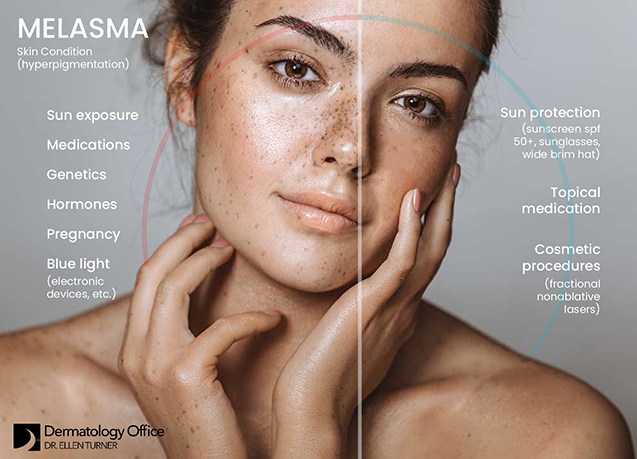Medical Dermatology
Melasma
- Home
- General Dermatology
- Melasma
Lighten Discolored Patches for a Clearer, More Even Skin Tone in Dallas
Dr. Ellen Turner provides treatments for melasma in the Dallas area, helping patients with the skin condition presenting as brown, tan, grayish-brown, or bluish gray flat patches on the face. Both sides of the face are usually affected. The most common sites of involvement are the cheeks, bridge of the nose, forehead, jawline, and upper lip.
Melasma typically occurs in women. Only 10 percent of those affected are men. Dark-skinned races—particularly Hispanic, Asian, and Indian people, along with those from the Middle East and Northern Africa—tend to be affected by melasma more than others, but people with light skin tones can also develop the telltale patches.
Medical Dermatology
Book an appointment online or call (214) 373-7546 to schedule an appointment to see us to treat melasma at our Dallas or Irving locations.
What Are the Symptoms of Melasma?
Melasma usually develops on areas of the face such as the bridge of the nose, forehead, cheeks, upper lip, and chin. It may also appear on other sun-exposed areas of the body, including the forearms, jawline, neck, and shoulders or elsewhere. The blotchy or freckle-like patches associated with melasma are a shade or two darker than the individual’s normal skin tone, symmetrical, and an even color. Sometimes the unevenly shaped patches can join up and cover a large area of skin, and they may be more noticeable in one area than another.
Melasma isn’t a dangerous health condition, but it can affect the way you look—as well as your self-image and confidence. Although these patches of discoloration don’t hurt, itch, or cause any physical harm, they may have an emotional impact and lower self-esteem, since many individuals are self-conscious about their appearance because of the condition.
What Are the Causes and Risk Factors for Melasma?
The precise cause of melasma is unknown. It’s likely that it occurs because pigment-producing cells in the skin malfunction and produce excess melanin. People with a family history of melasma are more likely to develop the problem themselves.
It is commonly associated with pregnancy, possibly due to pregnancy hormones. This has earned it the nickname chloasma, or the “mask of pregnancy.” Birth control pills and hormone replacement therapy may also play a role.
Sun exposure contributes to and worsens the problem because it affects the cells that control pigment, so it occurs more frequently in people who live in areas where there are high levels of sun exposure. Incidental exposure to the sun, even if it is only for a few minutes a day, is the main reason for recurrences.
Melasma is a general dermatology condition not typically associated with any internal disease or organ malfunction, but skin care products that irritate the skin, stress, and thyroid disease are also associated with the patches.

When it comes to melasma, the Dallas and Irving-based team at the Dermatology Office explains that while the condition is often associated with pregnancy, there are many triggers that could cause spots to appear and darken. Multiple treatments are available to help manage the problem and lighten the hyperpigmentation, including lasers and topical applications.
Melasma Treatment in the Dallas Area
Many people who have melasma don’t require treatment because the patches can fade away on their own. If the condition is linked to pregnancy or birth control pills, it’s likely that it will resolve naturally over time. However, if it doesn’t fade away or you’re self-conscious about your appearance and dislike the way the discoloration looks, there are treatments available to reduce the visibility of the patches.
While there is no cure, there are many melasma treatments that have been developed to manage the symptoms. It’s better to treat the discoloration as early as possible because it can be more difficult to lighten it if the patient has had the condition for many years.
Sunscreens are essential in the treatment of melasma. They should be broad-spectrum, protecting against both UVA and UVB rays from the sun. Select an SPF of 30 or higher.
In addition, physical sun blocks, which contain either zinc oxide or titanium dioxide, are used to block and reflect the ultraviolet radiation and visible light. This is important because chemical sunscreens (all active ingredients other than zinc oxide or titanium dioxide) typically work by absorbing light and converting it to heat, which can actually worsen melasma. Thus, chemical sunscreens should not be used—only physical sunscreens.
Sunscreens should be worn daily, whether or not it is sunny outside, or if you are outdoors or indoors. You can also wear a wide-brimmed hat to shield your face from sun exposure. Significant ultraviolet radiation reaches the skin while you are walking down the street, driving in a car, and sitting next to windows.
A variety of lightening creams are available for the treatment of melasma. These creams lighten the skin by inhibiting the ability of the melanocytes to decrease production of pigment. Hydroquinone is considered the gold standard for melasma treatment and is most effective and safe when used at the 4 percent strength twice daily. Certain skin care systems contain multiple steps of hydroquinone plus other prescription-strength agents that help to penetrate the hydroquinone even deeper into the skin where some of the pigment lies. Other medications that have been found to help are azelaic acid and tranexamic acid. Makeup can also be used to conceal areas of discoloration. Prescription oral tranexamic acid can be used as well in refractory cases of melasma, but Dr. Ellen Turner must evaluate patients medically to determine if they are appropriate candidates for therapy.
Procedures can be performed in office by licensed aestheticians for melasma. Microneedling, peels, and the picosecond laser have all been successfully employed in the treatment of melasma at the Dermatology Office because they do not create heat as a by-product of the procedure. Each of these procedures can also successfully treat all skin types, including the darkest of skin, which frequently has issues with melasma and discoloration.
Typically, it takes about three months to substantially improve melasma, so it’s important to keep following your dermatologist’s advice, even if you haven’t seen any improvements as yet. Remember to always layer two physical block sunscreens in addition to skin-lightening agents. While treatments lighten the discoloration, they won’t cure it completely. There is no guarantee that the condition won’t return or that it can be removed altogether. You will need to continue applying treatments to your skin even after the patches clear away to prevent melasma from returning.
Dermatology Office
Meet Dr. Ellen Turner
Dr. Ellen Turner and her staff at the Dermatology Office strive to work within a space where compassion meets technology to obtain top results for Dallas patients.


Chemical peels, microdermabrasion, and laser resurfacing may help, but results have not been consistent among individuals. These procedures have the potential of causing irritation, which can sometimes worsen the problem. Generally, they should only be used by a dermatologist in conjunction with a proper regimen of bleaching creams and prescription creams tailored to your skin type. Additionally, it is important to remember that any laser or light treatments for the treatment of melasma are not clinically indicated during the summer months between May and September.
Management of melasma requires a comprehensive and professional approach. Avoidance of sun and irritants, use of sunscreens, application of depigmenting agents, and close supervision can lead to a successful outcome. Dr. Turner prizes outstanding patient care and makes every effort to listen to her patients’ concerns, then help them to choose an appropriate therapy. Patients describe consultations with her as comfortable, informative, and respectful.
How Much Does Melasma Treatment Cost?
The treatment cost will depend on which specific treatment is chosen, and for how long the sessions last.

